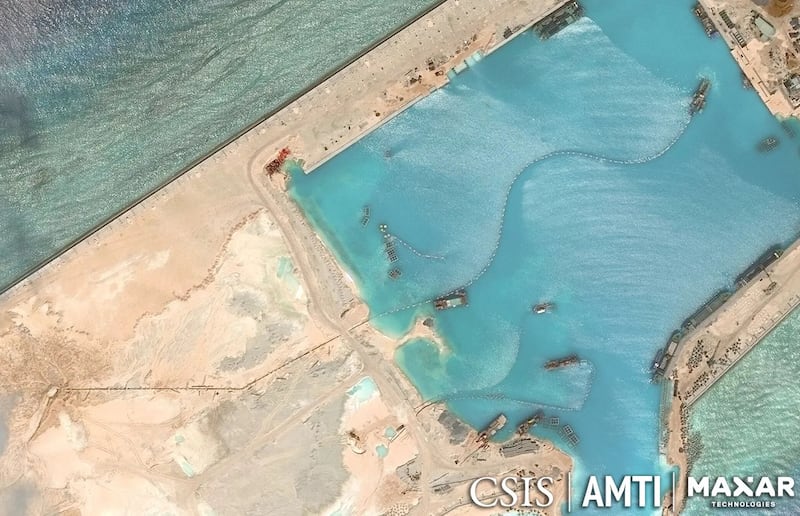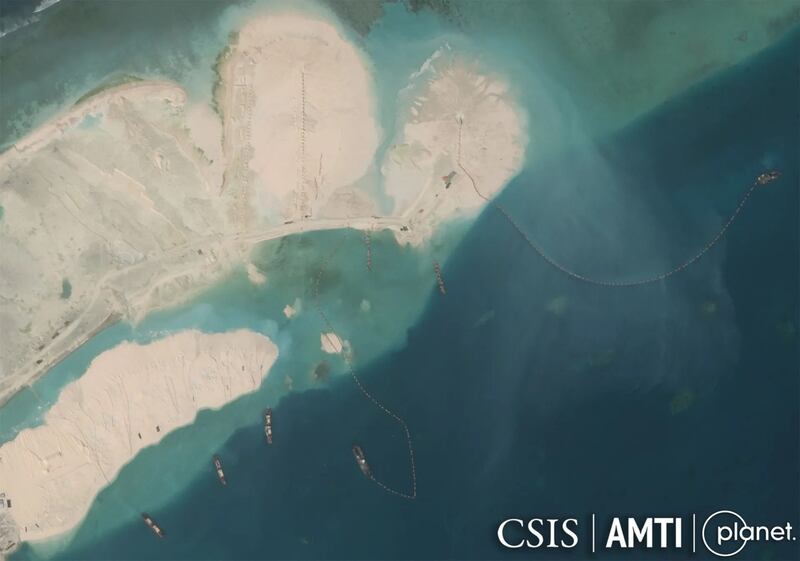Vietnam has actively pursued its major expansion plan in the disputed South China Sea, nearly doubling newly-reclaimed areas in one year, a new report said.
Since December 2022, "Vietnam has created another 330 acres [133.5 hectares] of land" on rocks and reefs within the Spratly archipelago, according to the report by the Asia Maritime Transparency Initiative, or AMTI, at the U.S. Center for Strategic and International Studies, or CSIS, think tank.
That was in addition to the 420 acres (170 hectares) reclaimed in 2022.
“By contrast, Vietnam had created just 120 acres [48 hectares] of land in the Spratlys between 2012 and 2022,” the report said.
“This all adds up to about a quarter of the more than 3,200 acres [1,295 hectares] of land created by China from 2013 to 2016, but it is far more island expansion than any other claimant besides China has undertaken.”
The report looked into five Vietnamese outposts in the sea, including Barque Canada Reef which “has undergone the largest transformation by far.”
Last week Radio Free Asia reported on the remarkable pace of reclamation on the reef.
“Formerly one of Vietnam’s smallest outposts, over 210 acres [85 hectares] of new land have been created at Barque Canada in the last year, making it now the largest Vietnamese-occupied feature in the South China Sea,” AMTI’s report said.
Other features that have been built up rapidly are Pearson Reef, Namyit Island, Sand Cay and Tennent Reef.
AMTI said dredging and landfill have also continued, though at a smaller scale, at Alison Reef, Cornwallis South Reef, Ladd Reef, and Discovery Great Reef, indicating that “a major expansion of any of these reefs in the future cannot be ruled out.”
The report noted that the focus of Vietnam’s efforts remains “primarily on dredging and landfill, with construction of infrastructure yet to begin in earnest at most features.”
Cutter suction dredgers
While examining satellite imagery, AMTI researchers discovered that in order to accelerate its dredging efforts, “Vietnam has turned to a tool that it had previously shied away from: cutter suction dredgers.”
A cutter suction dredger cuts hard soil or rock on the seabed into fragments with a rotating head. The material is then sucked up by dredge pumps and discharged to a deposit area through pipelines across sea and land.

At Barque Canada Reef on Nov. 2, 2023, at least two such dredgers could be seen clearly on the image provided by the U.S. satellite imaging company Planet Labs. Another two were present at Pearson Reef on Oct. 27, 2023.
They “are of the same type that China was criticized for using during its island-building campaign in 2014-2017 due to their outsize ecological impact,” the report said.
Dredging can be harmful to the marine environment due to physical effects on coral and seagrass, said Victoria Todd, Managing Director & Chief Scientist at Ocean Science Consulting Ltd.
“Collisions, noise production, and increased seabed disturbance can affect marine life directly,” she told RFA.
“Indirectly, changes in environment characteristics, such as topography, depth, sediment particle size … can also affect them,” Todd said, adding that the issue is “highly complex and should be studied carefully.”
“How much and how long-term the impacts are very much depends on where and how dredging is being carried out.”
Previously, Vietnam used clamshell dredgers and construction equipment to scoop up sections of shallow reef and deposit the sediment on the landfill areas. This method is considered more time-consuming but less destructive than cutter suction dredging.
“The use of cutter suction dredgers is worrying because they are more environmentally destructive than traditional methods, but even more so because they risk playing into China’s information operations,” said Greg Poling, AMTI’s director.
Information battle
"This round of land reclamation is just at the beginning," said the Chinese think tank South China Sea Probing Initiative (SCSPI) on the social media platform X previously known as Twitter.
“Ever since 1970s, Vietnam has never stopped expanding its outposts in Spratly Islands,” SCSPI added.
China has developed and fully militarized three artificial islands in the South China Sea, including Mischief Reef, Subi Reef and Fiery Cross, with missile arsenals, airfields and aircraft hangars, radar systems and other military facilities.
Yet “Chinese actors are trying to paint Vietnam as the one really militarizing and destabilizing the South China Sea,” said AMTI’s Poling.
“Vietnam appears to only be using these kinds of dredgers to create new harbors and for the major expansion of Barque Canada, so it's still a much smaller environmental impact than China's dredging had.”
“But that nuance could be lost in the narrative battle between Beijing and Hanoi,” warned the maritime analyst.

The Vietnamese government has yet to say anything about the AMTI report but Hanoi’s official stance has been that it only carries out works to protect the features but not to expand or change the structures of islands under its control.
“There is a saying in Vietnamese: ‘When you meet with Buddha, wear a monk’s robe but when you see a ghost, put on a paper dress’, which means: When in Rome do what the Romans do,” said Song Phan, a Sydney-based South China Sea researcher.
“Many of my colleagues think it is not advisable for Vietnam to sit idle when its big neighbor is behaving so assertively,” Song added.. “I don’t necessarily agree with them though. In my opinion, all sides need to strive to preserve the status quo in the sea.”
The apparent island-building campaign, however, has become a hot topic on internet forums in Vietnam, with netizens praising the government’s efforts.
“Worth every penny,” reads a comment by Dung Nguyen on a defense forum called Truong Sa Ngay Moi.
“Hope we can accelerate the island expansion even faster before our “friend” decides to disrupt it,” said another blogger, Hieu Do Van.
Edited by Mike Firn and Taejun Kang.
